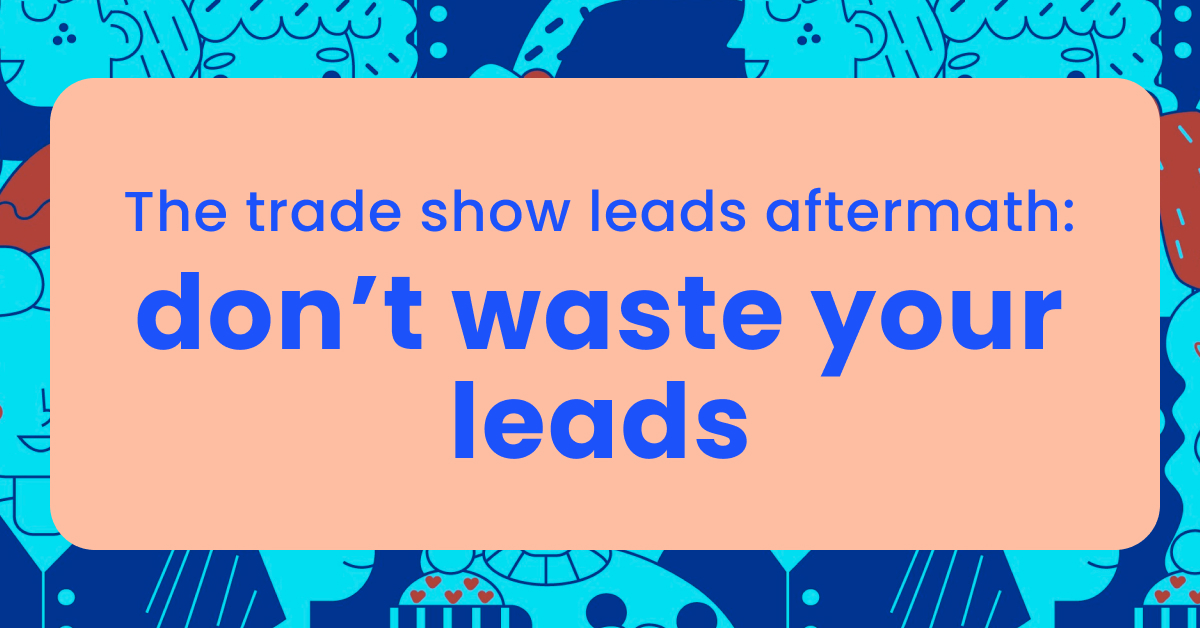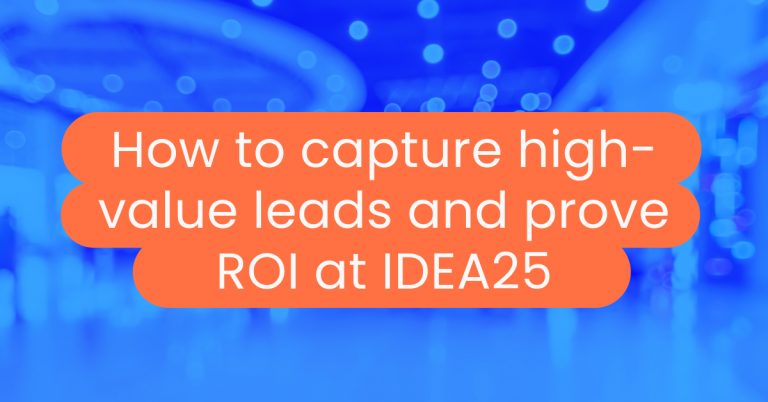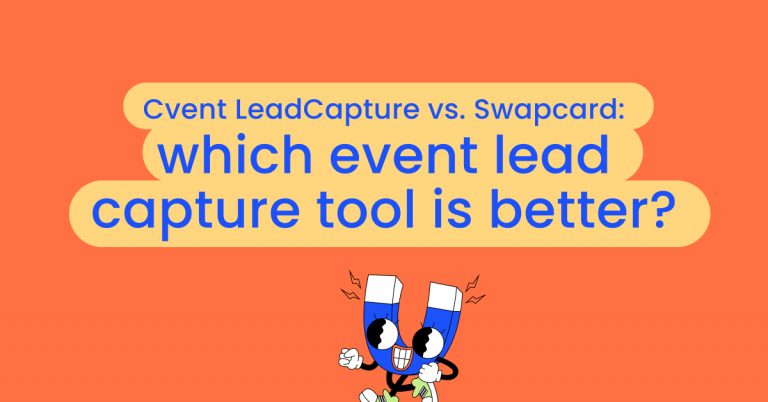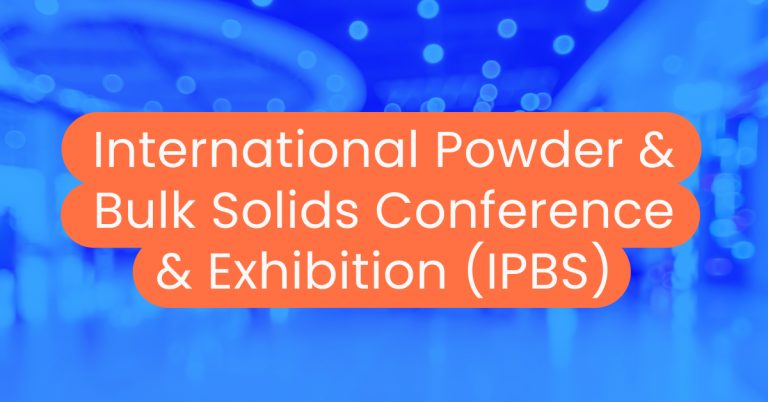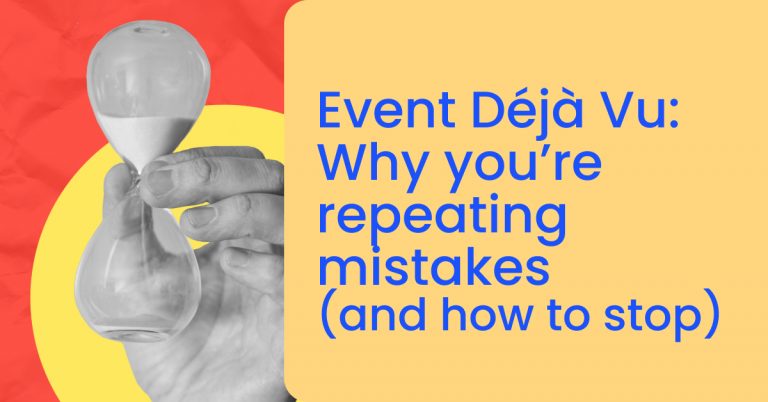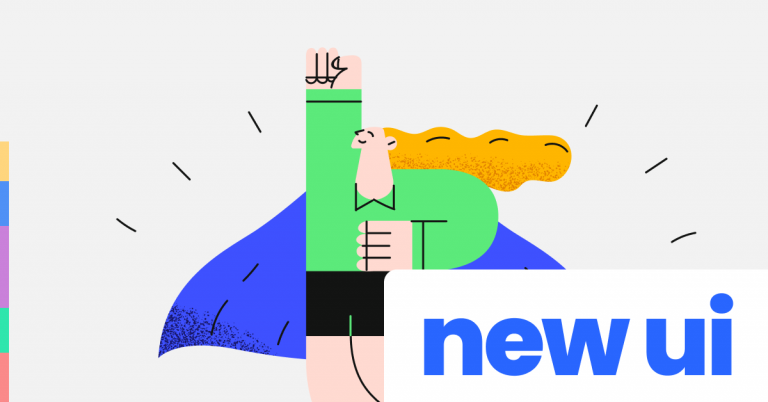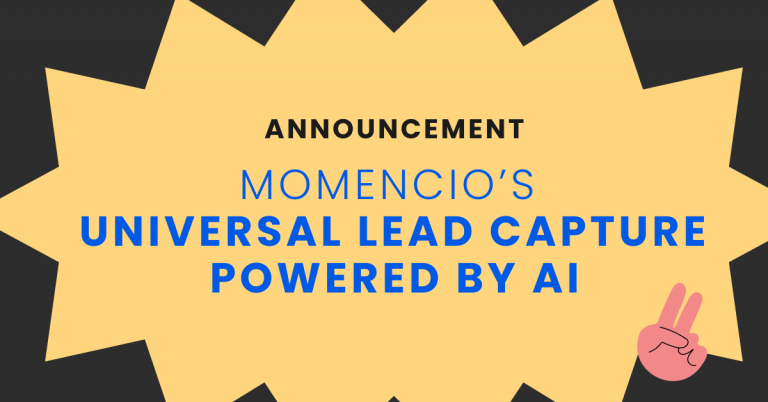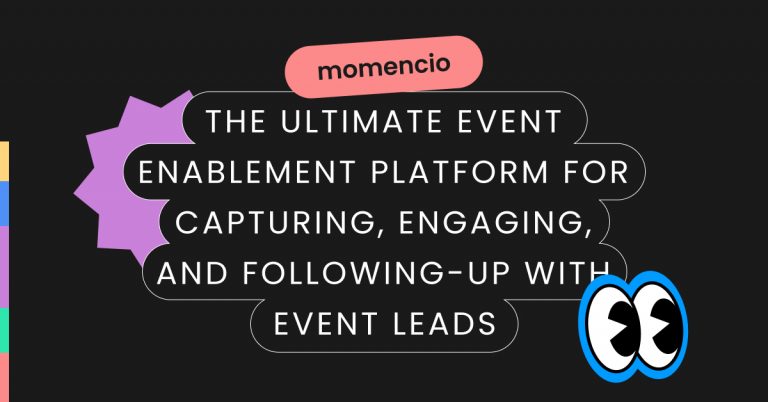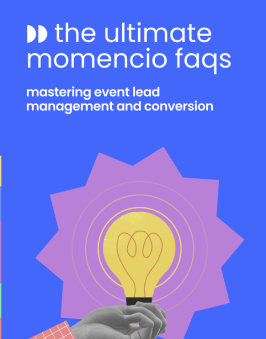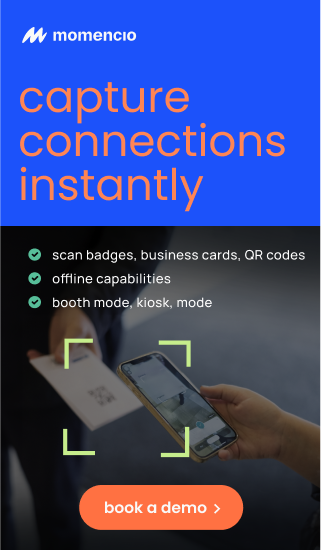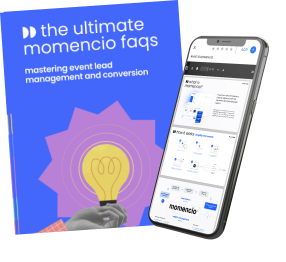The trade show is over, the booth is packed up, and your team is back at the office. Now what? For many exhibitors, post-event reality hits hard—hundreds of scanned business cards, scattered notes, and a contact list that seems promising but rarely leads to actual sales. Without a structured follow-up plan, most of those trade show leads will never turn into revenue.
Research shows that 79% of marketing leads never convert due to lack of follow-up. Even worse, the longer you wait, the more interest fades—50% of buyers choose the vendor that follows up first. Yet, despite these statistics, most companies still struggle with lead management after events, either delaying outreach or relying on generic follow-ups that fail to re-engage prospects.
Turning trade show leads into actual sales isn’t just about persistence—it’s about timing, personalization, and strategic nurturing. A well-executed follow-up plan doesn’t just increase conversion rates; it ensures that your event investment delivers measurable ROI.
So, what happens to most trade show leads after an event, and how can you ensure yours don’t go to waste?
TL;DR: Exhibitors invest thousands in trade shows, yet up to 80% of leads are never followed up on. Without a structured post-event strategy, potential deals slip away, and ROI plummets. The solution?
- Follow up within 24–48 hours while interest is high.
- Use multiple touchpoints, including LinkedIn, calls, and personalized emails.
- Segment leads by intent and tailor messaging accordingly.
- Balance automation with human interaction to nurture relationships.
- Track and optimize post-event engagement to improve conversion rates.
With the right approach, trade show leads turn into valuable business opportunities instead of wasted efforts.
Where most trade show leads go to die
The trade show floor is full of energy, excitement, and high-quality networking opportunities. Booths are packed with potential buyers, and business cards are exchanged at a rapid pace. But once the event ends, what happens to those leads? For most exhibitors, the answer is: nowhere.
1. Leads get buried in a database
A common mistake is treating leads as a collection rather than an opportunity. Many businesses scan badges, collect contact forms, or manually enter leads into a CRM, only for them to sit untouched for weeks—or even months. By the time someone remembers to follow up, the lead has moved on, forgotten the conversation, or chosen a competitor who followed up faster.
2. Lack of a structured follow-up plan
Many companies attend trade shows with no clear post-event strategy. The marketing team hands over a spreadsheet of leads to sales, but without a structured workflow, those leads are either contacted too late or not at all. Studies show that leads contacted within 48 hours of an event are 60% more likely to convert than those contacted after a week. Yet, most companies miss this crucial window of opportunity.
3. Generic and uninspired outreach
Another major issue is poorly crafted follow-ups that feel robotic and impersonal. Sending a generic email that reads: “Great meeting you at [Event Name]! Let’s schedule a call” does little to reignite interest. Leads need to be reminded of why they engaged with your booth in the first place. A follow-up should reference specific conversations, pain points, or interests the lead expressed during the event.
4. Overlooking lead segmentation
Not all leads are created equal. Some are ready to buy, some need nurturing, and others were simply curious. Without segmenting leads based on intent, engagement level, and buying stage, sales teams waste time on cold prospects while missing high-value opportunities. A hot lead who requested a demo should not receive the same follow-up as someone who just grabbed a free giveaway.
5. No multi-touch engagement
Many businesses rely solely on email to follow up with leads, ignoring other, more effective channels like LinkedIn, direct calls, or even SMS. A single email follow-up often gets lost in a crowded inbox. A multi-touch follow-up sequence—combining personalized emails, LinkedIn messages, phone calls, and remarketing ads—dramatically increases engagement rates.
6. Sales and marketing misalignment
Sales and marketing often operate in silos when it comes to trade show leads. Marketing collects leads and passes them to sales, but without a clear lead scoring system, sales enablement materials, or proper communication, those leads often go to waste. Sales teams need detailed insights into what prospects engaged with at the event, what content they consumed, and what their pain points are—so that follow-ups are highly relevant and conversion-focused.
How to stop leads from dying
Fixing these common issues requires a structured, strategic, and timely follow-up approach. The key elements include:
- A clear post-event workflow that ensures leads are contacted within 24–48 hours.
- Lead segmentation to prioritize hot prospects and nurture colder ones.
- Personalized outreach based on each lead’s engagement level.
- Multi-channel follow-ups that go beyond just email.
- Alignment between marketing and sales to ensure every lead is given a clear next step.
Most trade show leads don’t die because they weren’t interested—they die because they weren’t nurtured properly.
The biggest post-event follow-up mistakes killing your conversions
Trade show leads are full of potential, but a single misstep in follow-up strategy can send them straight into the void. Many exhibitors fail to convert leads, not because their product or service isn’t compelling, but because their approach is ineffective, generic, or poorly timed. Here are the biggest post-event follow-up mistakes and how to fix them.
1. Waiting too long to follow up
Time is the enemy of trade show success. The longer you wait, the colder the lead becomes. Research shows that leads contacted within 24–48 hours of an event are 60% more likely to convert than those contacted after a week. Yet, many exhibitors delay their outreach for days—or even weeks—losing momentum and allowing competitors to swoop in.
Fix it:
- Send an initial email within 24 hours of the event while interest is high.
- Follow up with a second touchpoint (call, LinkedIn message) within 48 hours to reinforce the connection.
- Use scheduling tools to automate the first wave of follow-ups so no lead is forgotten.
2. Sending generic, uninspired messages
A vague “Great meeting you at [Event Name]! Let’s connect soon” email does nothing to re-engage a prospect. If a follow-up email feels like it could have been sent to 500 other people, it’s unlikely to get a response. Leads need a reason to continue the conversation.
Fix it:
- Personalize every follow-up by referencing specific conversations, pain points, or topics discussed at the event.
- Provide value in each message, such as a relevant case study, a custom product recommendation, or insights tied to their industry.
- Use dynamic email templates that allow for personalized details while maintaining efficiency.
3. Relying only on email
Most trade show follow-ups rely solely on email, but inboxes are overflowing. With average email open rates hovering around 20%, relying on email alone means that 80% of your leads may never even see your message.
Fix it:
- Use a multi-channel approach that includes LinkedIn, phone calls, SMS, and even retargeting ads to stay top-of-mind.
- Engage on social media by commenting on a prospect’s LinkedIn posts before reaching out directly.
- Mix up the format—try a personalized video message instead of another text-based email.
4. Treating all leads the same
Not all trade show leads are created equal. Some are ready to buy, while others are just exploring options. Sending the same follow-up to everyone leads to missed opportunities and wasted time.
Fix it:
- Segment leads into categories: hot (ready to buy), warm (interested but needs nurturing), and cold (minimal interest).
- Adjust follow-up messaging based on the segment—hot leads should receive direct calls, while warm leads benefit from educational content before a sales conversation.
- Use CRM and lead scoring tools to prioritize high-value prospects.
5. Failing to nurture leads over time
Many exhibitors give up after one or two follow-ups, assuming a lack of response means disinterest. However, 80% of sales require at least five follow-ups, yet 44% of salespeople give up after just one attempt.
Fix it:
- Create a long-term nurture sequence that continues engaging leads over weeks or months.
- Use automation to schedule periodic check-ins, educational emails, and targeted offers.
- Track engagement metrics to determine when a lead is warming up and ready for a sales conversation.
6. Lack of coordination between sales and marketing
Marketing teams often collect leads, but sales teams are left in the dark about how those leads were acquired, what prospects engaged with, and what their interests are. Without proper alignment, sales outreach can feel disconnected and uninformed.
Fix it:
- Ensure that marketing provides detailed lead insights to sales, including booth interactions, downloaded materials, and conversation notes.
- Use a shared CRM where both teams can track lead status, follow-up activity, and engagement history.
- Schedule post-event debriefs to refine the follow-up strategy based on real insights.
7. Not tracking and optimizing follow-up performance
If you’re not measuring follow-up success, you have no way to improve it. Many teams send emails and make calls without analyzing what works, what doesn’t, and where leads are dropping off.
Fix it:
- Track key metrics such as email open rates, response rates, and conversion rates.
- A/B test different subject lines, follow-up timings, and call scripts to see what resonates best with prospects.
- Refine the follow-up cadence based on data-driven insights—adjust frequency, messaging, and channels for better engagement.
Final thoughts: follow-up mistakes are preventable
The biggest mistakes exhibitors make with trade show leads aren’t about the quality of their product—it’s about timing, messaging, and execution. Avoiding these common pitfalls ensures that every lead is given the right level of attention, nurtured effectively, and guided toward conversion.
The perfect follow-up timeline: when and how to re-engage leads
The window of opportunity after a trade show is short. Leads that seemed eager to engage at your booth quickly become distracted by daily responsibilities, and their interest fades fast. The key to keeping them engaged is a structured follow-up timeline that ensures the right touchpoints at the right time.
1. The first 24 hours: the golden window
The first 24 hours after a trade show are crucial. Leads are 100 times more likely to respond if contacted within the first day. Delaying outreach means risking the loss of momentum and interest.
Action steps:
- Send a personalized email thanking them for visiting your booth and recapping key points from your conversation.
- Connect on LinkedIn with a short, friendly message referencing your meeting.
- Assign follow-up tasks in your CRM to ensure no lead slips through the cracks.
2. Day 2–3: follow-up with added value
After the initial outreach, it’s time to move beyond pleasantries. Leads need a reason to keep engaging with your brand.
Action steps:
- Send a relevant resource such as a case study, white paper, or blog post related to their pain points.
- Invite them to a post-event webinar to expand on key insights from the trade show.
- Offer a short call to discuss their needs further and how your solution can help.
3. Day 4–7: introduce social proof
By the end of the first week, leads are either warming up or cooling down. To push them forward, social proof becomes a powerful tool.
Action steps:
- Share a customer success story that aligns with their industry or challenges.
- Send a quick video message summarizing your solution and why it’s a great fit for them.
- Engage with their LinkedIn posts to stay on their radar without being overly pushy.
4. Week 2: re-engagement with a personalized approach
At this point, leads who haven’t responded yet may need a fresh reason to engage. A personalized follow-up tailored to their specific concerns can reignite interest.
Action steps:
- Send a direct email addressing their specific pain points and offering tailored solutions.
- Provide an exclusive offer such as a limited-time discount or a VIP consultation.
- Use retargeting ads to remind them of your brand as they browse online.
5. Week 3–4: the final nudge
Some leads take longer to make decisions, but that doesn’t mean they should be forgotten. A final, well-crafted nudge can turn a silent prospect into an engaged one.
Action steps:
- Send a “last chance” email offering a meeting before closing out their file.
- Share industry trends or insights to showcase your company’s expertise.
- Ask for feedback—if they’re not interested, understanding why can improve future follow-ups.
6. Long-term nurturing: keeping the relationship alive
Not all leads will be ready to convert immediately, but that doesn’t mean they won’t in the future. A long-term nurture campaign keeps your brand top-of-mind without being intrusive.
Action steps:
- Enroll cold leads in a monthly newsletter featuring relevant content.
- Periodically check in with non-sales emails, such as an invite to an industry event.
- Monitor engagement metrics to identify when a lead starts showing renewed interest.
Final thoughts: consistency wins the follow-up game
A great trade show lead follow-up strategy isn’t about a single email—it’s about a series of well-timed, value-driven touchpoints. By following a structured timeline, engaging across multiple channels, and personalizing outreach, exhibitors can turn fleeting event interactions into long-term business relationships.
Personalization vs. automation: the key to post-event engagement
Post-event follow-ups require a careful balance between automation for efficiency and personalization for meaningful engagement. Many exhibitors struggle with this—either relying too much on generic automated emails or spending excessive time manually crafting each follow-up. The key is knowing when to automate and when to personalize so leads feel valued while your team remains productive.
1. Why personalization matters after an event
Trade show attendees engage with multiple vendors, making it easy for them to forget specific conversations. A generic, automated email won’t spark recognition, but a personalized message referencing your actual discussion will. Personalized outreach increases response rates by 26%.
How to personalize effectively:
- Mention the conversation you had—remind them what was discussed and why they showed interest.
- Reference specific pain points—connect their business challenges with how your solution helps.
- Use their first name and company name—simple but effective in making an email feel personal.
- Send industry-specific content—share relevant insights, white papers, or case studies tailored to their niche.
2. Where automation fits in
Automation is invaluable for maintaining consistency and ensuring no lead slips through the cracks. A structured post-event sequence helps warm leads stay engaged without requiring manual effort for every touchpoint. However, automation should enhance—not replace—genuine human interaction.
Best uses of automation:
- Drip email sequences—schedule a series of emails to nurture leads over time.
- Lead scoring—automatically categorize leads based on engagement and prioritize high-intent prospects.
- Follow-up reminders—trigger tasks in your CRM so sales reps know when to check in personally.
- Meeting scheduling links—simplify the booking process with an automated calendar tool.
3. Striking the right balance: when to automate and when to personalize
A blended approach ensures efficiency without losing the human touch. Here’s a simple framework for when to personalize and when to automate in post-event follow-ups:
| Stage | Personalization | Automation |
| First 24 hours | Personal, customized email referencing your booth conversation. | CRM task reminders to ensure follow-ups aren’t missed. |
| Days 2–5 | Personalized LinkedIn connection with a short message. | Automated email with an industry-specific resource. |
| Week 2–3 | Manual call for high-value leads. | Drip campaign for warm leads with nurturing content. |
| Month 1+ | Personalized invitation to a webinar or consultation. | Retargeting ads to stay top-of-mind. |
4. Personalization at scale: leveraging AI and smart automation
New tools make it possible to scale personalization without losing authenticity. AI-powered CRMs can suggest relevant follow-up messages based on past interactions, while dynamic email templates allow reps to add personal touches without rewriting every email from scratch.
Ways to use AI and smart automation:
- AI-driven email customization—pulls in event data to craft personalized follow-ups.
- Chatbots for immediate responses—engage leads in real-time before a human takes over.
- Smart scheduling tools—suggest the best time for meetings based on lead behavior.
Final thoughts: technology should enhance, not replace relationships
Automation keeps the process running smoothly, but real connections are what drive conversions. The best approach? Use automation for consistency and personalization for impact—ensuring leads feel valued while keeping your sales process scalable.
Beyond emails: creative ways to keep leads engaged after the event
Email follow-ups are essential, but they can only take you so far. Most trade show attendees receive a flood of emails after an event, making it difficult for any single message to stand out. To ensure meaningful engagement, businesses need to think beyond traditional email follow-ups and explore unexpected, creative methods to keep prospects interested.
1. Turn leads into participants with interactive content
People don’t just want to receive information—they want to engage with it. Interactive content captures attention, encourages participation, and keeps leads engaged.
How to use interactive content:
- Create a post-event survey that asks attendees about their biggest event takeaways and challenges. In return, offer them a custom industry report based on aggregated responses.
- Develop a decision-making quiz that helps prospects determine which of your solutions fits their needs best.
- Host an interactive LinkedIn poll where prospects can vote on industry trends, creating an opportunity for further discussion.
2. Leverage exclusive post-event micro-communities
Rather than sending another email, invite your leads to something more exclusive—a private LinkedIn or Slack group where they can continue networking and discussing trade show insights.
How to make micro-communities work:
- Start a “Trade Show Insiders” LinkedIn group where attendees can discuss challenges and exchange ideas.
- Create a Slack channel for VIP prospects where they can get first access to insights, special offers, and industry events.
- Encourage community engagement by sharing exclusive content, hosting live Q&As, and facilitating peer-to-peer discussions.
3. Use behind-the-scenes event content to re-engage leads
Many leads attend trade shows but don’t get a full view of everything you had to offer. Sharing behind-the-scenes content helps reignite interest and reinforce your brand’s personality.
Creative ways to repurpose event content:
- Create a “What You Missed” highlight reel featuring key moments from your booth, product demos, or speaker sessions.
- Share candid team videos that show a more personal, human side of your brand.
- Post a “Top 5 Trade Show Insights” carousel on LinkedIn to spark conversations.
4. Gamify post-event engagement
Gamification makes post-event follow-ups more exciting and memorable. A well-structured challenge or contest can boost lead interaction while keeping your brand top-of-mind.
Gamification ideas for trade show follow-ups:
- A “Follow-Up Challenge”—reward leads who engage with multiple touchpoints (e.g., attending a webinar, booking a demo, answering a survey) with an exclusive gift or discount.
- Trivia contests related to your industry—host a fun, competitive quiz where winners get early access to product trials or insider insights.
- A scavenger hunt-style email campaign—where leads must find hidden clues in your content for a reward.
5. Offer an unexpected follow-up format: audio messages & podcasts
Instead of another written message, send a short audio note to high-value leads or direct them to an industry-focused podcast episode. Hearing your voice creates a stronger personal connection than text alone.
Ways to use audio & podcasts in follow-ups:
- Send a quick voice message on LinkedIn or WhatsApp recapping your trade show conversation.
- Record a 2-minute personalized audio message thanking leads for visiting your booth and offering next steps.
- Direct leads to a podcast episode where your company discusses key event takeaways.
6. Create limited-access, “invite-only” experiences
People love exclusivity. Offering invite-only experiences makes leads feel like VIPs and keeps them engaged long after the event.
How to make it work:
- Host a small, invite-only virtual roundtable for key leads to discuss industry trends.
- Offer a behind-the-scenes look at an upcoming product launch to select prospects.
- Send an exclusive invitation to an in-person networking dinner with industry peers.
7. Turn post-event engagement into a long-term content journey
Instead of treating follow-ups as a short-term effort, turn them into an ongoing content experience that keeps leads connected to your brand for months.
How to create a long-term content journey:
- Develop a “Trade Show to Success” email series that walks leads through best practices, insider knowledge, and use cases related to their industry.
- Turn trade show insights into an ongoing blog series where you dive deeper into key takeaways.
- Offer a mini-course or workshop related to their industry pain points, guiding them toward your solution.
Final thoughts: engagement is about experience, not just outreach
Successful post-event engagement is about creating an experience that keeps leads coming back. Moving beyond emails and into interactive, unexpected formats ensures that prospects stay connected long after the trade show ends.
Tracking success: how to measure and refine your post-event follow-up strategy
The effectiveness of a trade show follow-up strategy is only as good as the metrics and insights used to refine it. Without tracking key performance indicators (KPIs), businesses risk repeating ineffective outreach tactics and missing valuable engagement opportunities. Measuring success ensures that every trade show investment leads to tangible business outcomes and that future event strategies are continually optimized.
1. Key metrics to track follow-up performance
To optimize post-event follow-ups, exhibitors need to monitor data-driven indicators that highlight what’s working and what needs improvement.
Essential KPIs for post-event follow-ups:
- Response rate: Percentage of leads who engage after the initial follow-up, indicating interest.
- Email open & click-through rates: Measures how compelling subject lines and content are in capturing attention.
- Meeting conversion rate: Tracks how many leads book a demo or consultation after initial contact.
- Lead-to-opportunity ratio: Evaluates how many leads progress to the sales pipeline.
- Sales cycle length: Determines how long it takes to convert a trade show lead into a paying customer.
- ROI per trade show: Compares revenue generated from event leads to the total event investment, showing the true impact of participation.
- Engagement across multiple touchpoints: Tracks how leads interact with different channels like LinkedIn, calls, and content.
2. A/B testing for continuous improvement
Not all follow-up tactics perform equally well. A/B testing (split testing) allows businesses to compare different approaches and fine-tune outreach efforts.
What to A/B test:
- Email subject lines: Test variations to see which ones increase open rates and engagement.
- Follow-up timing: Compare results between immediate follow-ups vs. delayed outreach to determine the optimal window for response.
- Message personalization: See if tailored content with specific event details improves response rates.
- Call-to-action (CTA) placement: Determine if direct vs. subtle CTAs lead to more conversions and faster sales cycles.
- Follow-up format: Experiment with text-based emails vs. video messages, LinkedIn InMails, or SMS to identify the most effective medium.
3. Using CRM and analytics tools to refine outreach
A well-integrated customer relationship management (CRM) system simplifies tracking and optimizing follow-ups. Platforms like HubSpot, Salesforce, and Marketo provide:
- Automated lead scoring to prioritize high-intent prospects based on engagement level.
- Real-time engagement tracking to monitor which leads are opening emails, clicking links, or visiting your website.
- Follow-up task automation ensuring that no lead is left unattended.
- Pipeline tracking and forecasting to understand how post-event leads contribute to long-term revenue.
- Custom reporting dashboards to visualize data, detect trends, and make data-driven decisions.
4. Identifying drop-off points and improving lead nurturing
Even with a structured follow-up sequence, some leads disengage. Identifying where engagement declines helps fine-tune the nurturing process and recover lost opportunities.
Common drop-off points:
- Leads who stop responding after the first follow-up, signaling a lack of immediate interest.
- Prospects who open emails but don’t click on links or take action.
- Attendees who express initial interest but never schedule a demo or meeting.
- Leads who visit your website but don’t engage further.
How to fix drop-off issues:
- Send targeted content—if a lead showed interest but didn’t engage, send a personalized case study or testimonial.
- Re-engage with a different channel—if emails aren’t working, try LinkedIn messaging or a phone call.
- Use retargeting ads to remind leads about your brand while they browse other websites.
- Offer a new incentive—if a lead went cold, a limited-time offer or exclusive invite to a webinar can rekindle interest.
5. Aligning sales and marketing for better results
A common reason follow-ups fail is misalignment between sales and marketing. Ensuring both teams work together creates a seamless lead handoff from event engagement to conversion.
How to align sales and marketing:
- Marketing should provide detailed lead insights—sales teams should know which booth interactions, downloads, or event sessions each lead engaged with.
- Sales should give feedback—track which messaging and follow-up tactics are driving conversions and refine marketing strategies accordingly.
- Use a shared CRM dashboard—ensure both teams have full visibility into the pipeline so no lead falls through the cracks.
- Develop a post-event playbook—a structured guide ensuring marketing and sales work in sync for every trade show follow-up.
6. Benchmarking against industry standards
To truly measure success, businesses must compare their performance against industry benchmarks to ensure they are ahead of competitors.
Examples of industry benchmarks:
- Average response time for trade show leads: The best-performing companies follow up within 24–48 hours.
- Typical email open rates: B2B event follow-up emails should achieve 20–30% open rates.
- Lead-to-conversion ratio: High-performing sales teams convert 15–20% of trade show leads into customers.
- Trade show ROI expectations: A strong event strategy should generate at least 5–10x return on investment.
Final thoughts: refine, optimize, and repeat
A trade show follow-up strategy should evolve based on real-time insights and continuous testing. By tracking KPIs, A/B testing messaging, leveraging CRM automation, and aligning sales and marketing efforts, businesses can transform post-event leads into long-term revenue opportunities.
Conclusion
Trade shows are one of the most powerful lead generation opportunities, yet most companies fail to capitalize on the leads they collect. The difference between wasted potential and actual revenue lies in how well you execute your follow-up strategy.
Key takeaways:
- Follow up within 24–48 hours for maximum engagement.
- Use a multi-channel approach—don’t rely on email alone.
- Segment leads and personalize outreach based on engagement level.
- Balance automation and personalization to scale effectively.
- Track key metrics to optimize and improve future follow-ups.
- Align sales and marketing to ensure a smooth handoff and lead nurturing process.
Want to transform your trade show leads into real sales? Book a demo with momencio and discover how real-time engagement tracking and automated workflows can help you close more deals.
Interesting facts from research
Understanding the importance of trade show follow-ups requires looking at real-world data. The following statistics highlight why a strategic post-event approach is critical:
- Companies that follow up with leads within 24 hours are 7x more likely to qualify them compared to those who wait longer.
- Businesses that use automated lead nurturing generate 50% more sales-ready leads at a 33% lower cost.
- Companies using multi-channel follow-ups (email, LinkedIn, phone calls) increase conversion rates by up to 300%.
- Trade shows generate more qualified leads than other marketing channels, but failure to follow up effectively makes this potential meaningless.
FAQs
- How soon should I follow up after a trade show?
- It’s best to reach out within 24 to 48 hours after the event. This timeframe ensures the conversation is still fresh in your lead’s mind, and research indicates that leads contacted within this window are seven times more likely to convert.
- What should my first follow-up message include?
- Your initial message should be personalized, referencing specific points from your conversation at the trade show. Provide something of immediate value, such as a relevant case study, white paper, or product guide, and end with a clear call to action—for instance, inviting them to book a call or schedule a demo.
- How many times should I follow up?
- Converting leads often requires at least five follow-ups, yet many businesses stop after one or two. A robust follow-up sequence that incorporates multiple touchpoints—email, LinkedIn, calls, and SMS—has a higher likelihood of success.
- Should I use automation for follow-ups?
- Automation can help maintain consistency, but it needs to be combined with personalized outreach, especially for high-value prospects. Automated sequences are useful for lead nurturing, while direct, personalized contact works best for those who have shown strong interest. A CRM can also prompt manual follow-ups to ensure no lead falls through the cracks.
- What are the best channels for follow-ups?
- Email is a core channel, but relying on it alone limits your reach. LinkedIn offers a way to connect and send short, direct messages. Phone calls tend to be highly effective for hot leads, and SMS can be used for warm leads or appointment reminders. Retargeting ads on social media and Google keep your brand top of mind.
- How do I segment my trade show leads?
- Segmentation is about prioritizing and tailoring your approach. Hot leads are ready to buy or close to making a decision, so schedule meetings with them right away. Warm leads need ongoing nurturing with relevant content, while cold leads can be placed in a long-term nurturing cycle until they show more interest.
- What’s the best way to measure follow-up success?
- Key indicators include your response rate (the percentage of leads who reply), meeting conversion rate (how many book calls or demos), and lead-to-opportunity ratio (how many leads progress into the sales pipeline). You should also track how long it takes to move from first contact to a closed deal, and compare the revenue generated from each trade show to the cost of attending.
- How can I stand out from other exhibitors following up?
- Most trade show attendees receive standard follow-up emails, so a personalized and creative approach is crucial. Try sending a short video message that references a specific moment at your booth, or offer exclusive post-event content like an invite-only webinar. You can also explore alternatives such as direct mail, interactive surveys, or voice messages.
- What should I do with leads who don’t respond?
- If you’re not getting a response through email, try another method—LinkedIn, phone calls, or SMS—to re-engage them. Send a re-engagement email with a new offer or some exclusive content, and consider using retargeting ads to keep your brand visible. If they remain unresponsive, move them into a long-term nurture sequence with educational content.
- How do I ensure sales and marketing alignment in follow-ups?
- Both teams should collaborate by sharing insights and data in a common CRM. Marketing provides context and lead information gathered from the trade show, while sales teams use those insights to tailor their conversations. Post-event debriefs also help refine messaging and strategies for future follow-ups.
